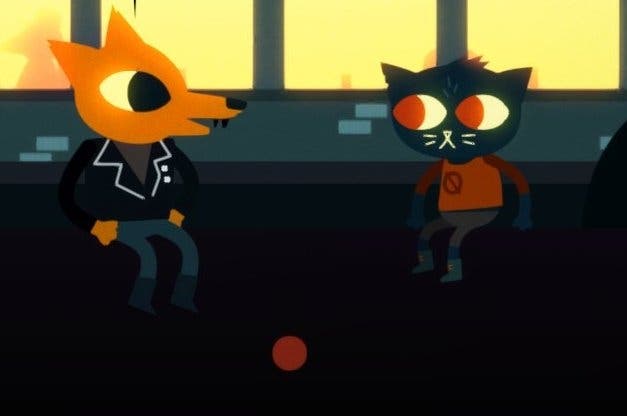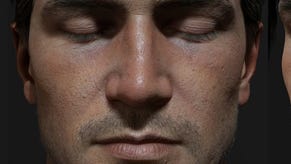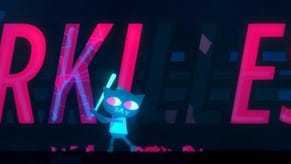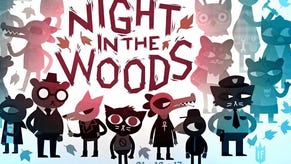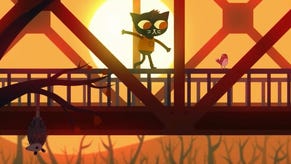Night in the Woods is like Gone Home, in third-person, with talking animals
Games, they are a'changin'.
Games, as a medium, allow us to experience things we don't get to in our everyday lives. Often these are empowering fantasies like saving the world and fighting monsters. Sometimes they're more abstract adventures like trotting through majestic, magical landscapes as in Journey. And occasionally these are dis-empowering satirical situations as we saw in games like Papers, Please or The Stanley Parable. While the medium excels at showing us a life we'll never lead, indie developers Alexander Holowka and Scott Benson's upcoming adventure, Night in the Woods, reflects a slice of life most of us have led: that of a wayward 20 year old.
On the surface, Night in the Woods might not look like our world. All the people are animals, for starters. An early anecdote about a girl electrocuted by a downed power line who's since lost the ability to use adjectives hints at a particularly silly setting, and, in true feline form, you're able to leap several feet into the air. These twee tweaks to the world suggest a far-flung fantasy, but Night in the Woods' world soon begins to resemble our own.
Assuming the role of Mae, a feline who's recently dropped out of college only to move back home with her folks in the suburban town of Possum Springs, we listlessly stroll through the streets on a bright summer day. Mae's in an awkward, transitional period between being an adolescent and adult. One minute her mom is telling her she's tool old to be jumping around, while the next a grumpy neighbor scolds her and her "kid" friend, to which she replies, "We're adults and we run the world now."
As I slink my way through the city, it becomes clear that a lot has changed in Possum Springs while Mae's been gone. Upon heading towards a graveyard Mae thinks to herself, "I feel like you might need Bea for the full graveyard experience," suggesting an old, possibly goth, high school drinking buddy. Her next thought bubble: "That was not a joke about her mother." Oh man. I'm so sorry, Bea!
This somber sense of unease is ubiquitous through this relatively uneventful day in the life of Mae. With nothing better to do, I make her stroll about town making small talk with the locals. A moody fellow classmate whines about her parents sending her to a therapist so she has to write her thoughts down in a journal: a confession Mae relates all too well to, as - what do you know - they go to the same doctor! Mae's former high school art teacher advises her to get out of town while she's still young, a 29-year-old telephone operator suggests the same on her smoke break, while one little girl says she's not allowed to talk to Mae as her mother told her that our heroine once "hurt somebody" and "no one knows when you might do it again."
It quickly becomes apparent that this is a very melancholy affair, but it's not all doom and gloom in suburbia. The cutesy character design and believably jokey dialogue add a lot of levity to Mae's identity and psychological crisis about growing up simultaneously too fast and too slow. Mae's wry observations about the subway tunnel feeling like a retirement home, her enthusiasm about her pal Gregg's theft of a lawn gnome ("Should we throw it off the roof?" "Is that even a question?"), and the most epic impromptu existential debate about the metaphorical importance of donuts you'll ever hear gives Night in the Woods a plucky charm that shines through all the broken dreams permeating this autumnal town and its wide berth of inhabitants.
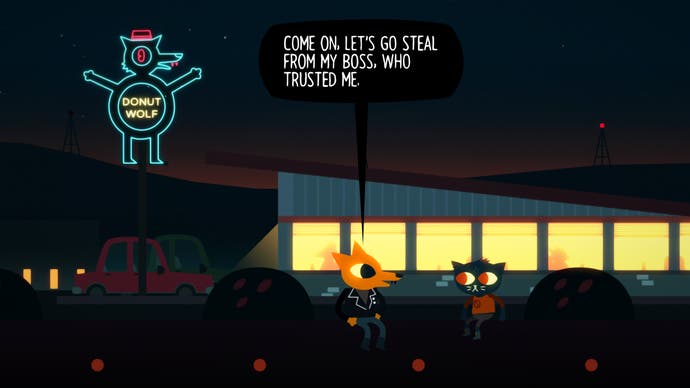
It's this earnestness and attention to detail in every day life that makes Night in the Woods stand out so far from what we typically associate from the medium. "The world in peril is boring, but heartbreak is the apocalypse," says Benson, summarising the sincere tone he and Holowka are aiming for with the game. "It takes tiny traumas, and failures, and victories and that's what's more interesting. I think a lot of games that would do those things would treat them very, very seriously. And we wanted to see it through the eyes of these wisecracking dumbass kids who are just kind of stumbling through all this stuff." This creative core is evident throughout in subtle details, like the way Mae playfully balances on rails, suggesting a flurry of boredom, creativity, frustration, self-doubt and unabashed, immortal-feeling optimism behind her unknowable cat eyes.
Cleverly, the objective log is presented as a to-do list in Mae's journal. This diary ranges from such impossible tasks as "hide soul in something, become immortal" to a collection of doodles signifying Mae's feelings. Sometimes this is a scrawl of a group of ennui-filled high school students labelled "teens suck," while a doodle of what appears to be a mummified fox in the stars suggests her desire to live forever (but hopefully not in Possum Springs, of course). Her journal entries and drawings are tethered to the choices you make and dialogue options you choose, which helps personalise the adventure while remaining true to Mae's renegade spirit.
The player will have to make lots of choices in Night in the Woods, but these aren't the sort of binary moral decisions we're used to. In fact, most of the choices aren't even framed as such and you're not supposed to know you're making them at all. "There's not going to be a 'nuke the town or save the town' [decision]," Benson explains. "It's more like 'do you hang out with this person?' Okay, cool. That person might not know you as well by the end of the game, but this person you hung out with, you're going to get to see their storyline."
"That's one of the themes too, is how you don't have infinite time," Holowka adds. As such, it's going to be impossible to see everything in one playthrough, but this won't be a drastically branching narrative. Just one that subtly adapts to how you choose to go about your day.
After a half hour I realise I haven't solved a single puzzle in Night in the Woods, or done anything remotely "gamey", and I don't care. Anything else would only get in the way of Mae's everyday life. You see, Night in the Woods' light interactivity - where the player has nothing to do but wander around, talk to people, and make observations - syncs perfectly with Mae's languid existence. In many ways, her life is mundane. But strut about a bit and get to know the locals and it's suddenly beautiful. Night in the Woods serves as a reminder that life may be dull, but being alive is anything but.
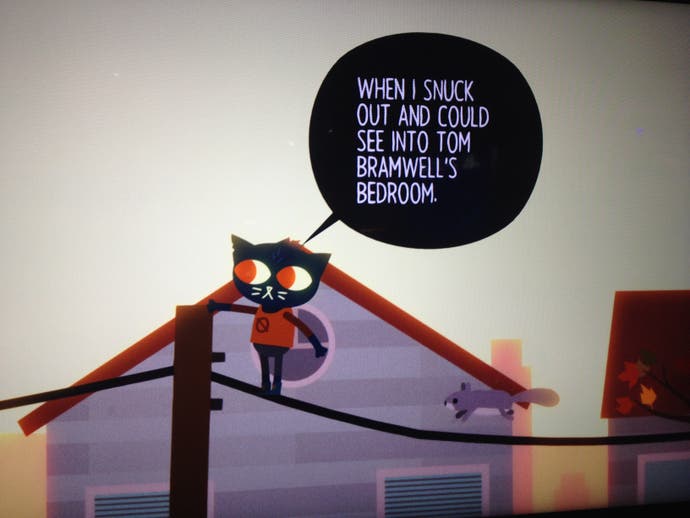
When I express my admiration for the E3 demo to Benson and Holowka, they appreciate the sentiment, but note that the demo won't be the same thing as the full release. Benson is adamant that "the tone is not going to change," but the developer will tinker with the dialogue and the storytelling. In other words, this is one of those "vertical slice" demos that accelerates the narrative to evoke the overall vision of a larger whole.
"A lot of this will be a bit more spread out, but I think there'll be a lot more stuff going on in town, characters kind of doing different things as you go by," Benson explains, before noting that the demo's core objective - to find your lonely friend Greg (and his stolen lawn gnome) on a roof - will probably not be something that actually happens in the final release. "It'll just be split up and chopped up and dispersed."
When I express concern that adding too much could stretch the narrative to thin, the pair confidently state that it will still be a dense experience. "I don't think it's going to be radically different," Holowka says. "We're okay erring on the side of the game being shorter as long as it doesn't feel padded. If we had to choose content over padding, we'd choose content."
I really, really love the E3 demo as it is, though. Given the immense talent on display, I'm sure the alterations and additions will be positive ones, but it still worries me that my visit to Possum Springs won't be quite as I remember when Night in the Woods makes its debut on PS4, PC and Mac later this year. Until then, Mae, promise me one thing: don't ever change.
